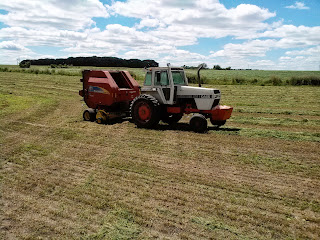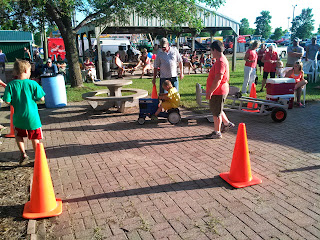Today, I'm going to explain the daily chores related to the robotic milkers.
To begin with, twice a day we wash the robots
and the robot room down with a hose.
When the milk leaves the robot
it is filtered on the way to the bulk tank.
We change that filter twice daily.
Next, we inspect the cups to make sure the air holes haven't plugged.
If they are plugged we use a tool that is like a mechanical pencil but
instead of lead it has a steel shaft the same size as the hole.
Also, once a day, we check to see if any hoses have holes in them.
The little gray circle on the small hose is a hole. When this happens,
we cut off the hose and shorten it up. Typically, the only time
the hoses get holes in them is when the cows kick the milkers.
The last thing we have to do is wash the lens for the laser off.
We spray a special cleaner on the lens and use a paper towel
to wipe it off. This is important because if the lens is dirty the
laser has trouble finding the teats.
A clean lens.
In addition to these tasks, we also look at the list of cows to see if any of them need
to milk but haven't come up on their own. We chase cows to the robots
four times a day. We wouldn't have to do it this often however, since we are
still milking some cows in the parlor and someone is doing chores anyway
we take 10 minutes to chase up the cows who haven't milked in awhile.
You probably can't read this screen because it is to small. This is what we look at to see who needs to be chased.
Tonight, there were 6 cows that hadn't been milked in over 9.5 hours. Today, there were 117 cows being milked by the robots. So that means 111 cows had milked in the last 9.5 hours.
When I looked at the list it included a cow that had "failed." A failure means that she was in the robot but for whatever reason couldn't get attached.
In addition, one cow on the list was moved to the parlor this morning but I hadn't programmed her out of the robot yet. So there were five cows to "catch." When I stepped into the barn I saw that two out of the five cows were up by the robots waiting their turn. So this meant that there were only three cows to find tonight.
It is usually the same cows and they know where to go so it doesn't take too long to get them. We chase them into a pen in the corner of the barn where the only way out of the pen is to walk through the robot.
The five cows I chased into the "catch pen".
After I chased the cows, I went to look at the computer.
I have a routine that I go through three times a day when looking at the computer. I look to see which cows are on the "udder health" list, which tells us if a cow has mastitis. There were no changes on this list tonight.
Next, I look to see if any cows need to be bred. Tonight there weren't any.
Last, I look to see which cows are down in production more than 10%. Tonight, there were four. This is higher than normal. Usually there is an explanation.
For example, tonight when I looked at the cows on the list one was down in production yesterday but she is back up today. Two were milked in the parlor for a milking so the computer didn't record that milking. One is sick, she is starting to come back in production after the vet treated her a couple of days ago. I look at her milk temperature, her weight, her activity, and her number of ruminations and it looks like she is starting to improve.
This whole process take about an hour. It can take longer if there are more cows to chase or if there are cows that need attention. The biggest benefit of the robots versus traditional milking is the flexibility. It doesn't matter if we do this at two in the afternoon or 10 o'clock at night which is especially nice when we are busy in the fields or when the kids have activities.



















































